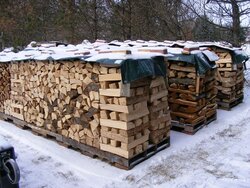I see comments concerning split size often in some of these post. I tend to use bigger splits because I think back to the days of the old King heater and we would load it heavy at night close the air and go to bed.
I know the company tells you, on the Fireview to put one good size split in the back and fill with small splits. Someone explain to me the ideas associated with that and why I need to go to the effort of spliting perfectly good 7 or 8 inch splits into 4 inch splits for them to burn up faster.
I do understand that I can put more splits in if they are smaller, but pure volume of wood may be more with larger splits. I know I probably could make a hotter fire with smaller splits but would they last as long? I like to hand split my wood but I don't like to do it so much that I want to split everything to 4 inches at the wides part.
I know the company tells you, on the Fireview to put one good size split in the back and fill with small splits. Someone explain to me the ideas associated with that and why I need to go to the effort of spliting perfectly good 7 or 8 inch splits into 4 inch splits for them to burn up faster.
I do understand that I can put more splits in if they are smaller, but pure volume of wood may be more with larger splits. I know I probably could make a hotter fire with smaller splits but would they last as long? I like to hand split my wood but I don't like to do it so much that I want to split everything to 4 inches at the wides part.


